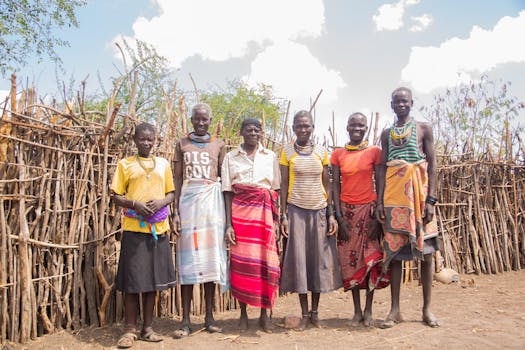
Connecting Cultures: The Story Behind Africa’s Diverse Fiber Traditions – WordPress
Africa’s diverse fiber traditions have been a cornerstone of the continent’s cultural heritage for centuries. From the vibrant colors of West African kente cloth to the intricate patterns of North African berber weaving, each region has its own unique textile art form that reflects the history, mythology, and values of its people. In this article, we will delve into the story behind Africa’s diverse fiber traditions and explore how they have been used to connect cultures across the continent.
Africa’s fiber traditions are as diverse as the continent itself. In West Africa, the Ashanti people of Ghana and the Ivory Coast are renowned for their kente cloth, which is woven from cotton and silk threads. The cloth is not only a symbol of wealth and status but also carries significant cultural and spiritual meaning. Each color and pattern has its own specific meaning, with red symbolizing life and vitality, while blue represents tranquility and peace. The kente cloth is also used to convey messages and tell stories, with different patterns and colors used to represent different proverbs and myths.
In North Africa, the berber people of Morocco and Algeria are known for their intricate weaving traditions. Berber weaving is characterized by its use of natural fibers such as wool and cotton, which are dyed using plant-based dyes. The weavings are often adorned with intricate patterns and symbols, which are used to convey messages and tell stories. Berber weaving is not only a form of artistic expression but also an important part of the region’s cultural heritage.
In East Africa, the Maasai people of Kenya and Tanzania are known for their vibrant beadwork and textile traditions. Maasai beadwork is characterized by its use of brightly colored beads, which are used to create intricate patterns and designs. The beadwork is not only a form of artistic expression but also an important part of Maasai culture and identity. The beads are used to convey messages and tell stories, with different colors and patterns used to represent different aspects of Maasai life and culture.
In addition to their cultural significance, Africa’s fiber traditions have also played an important role in the continent’s economic development. The textile industry is one of the largest employers in many African countries, with millions of people relying on it for their livelihood. The industry has also been an important source of foreign exchange, with many African countries exporting textiles to countries around the world.
Despite the significance of Africa’s fiber traditions, they are facing numerous challenges in the modern era. The rise of cheap synthetic fibers has led to a decline in the demand for traditional fibers, while the increasing cost of raw materials has made it difficult for many textile producers to remain competitive. Climate change has also had a significant impact on Africa’s fiber traditions, with changing weather patterns and increased temperatures affecting the quality and availability of raw materials.
To address these challenges, many organizations and individuals are working to promote and preserve Africa’s fiber traditions. The African Textile Forum, for example, is a platform that brings together textile producers, designers, and policymakers to promote the development of the textile industry in Africa. The forum provides a space for textile producers to showcase their products, share knowledge and expertise, and access new markets and technologies.
In conclusion, Africa’s diverse fiber traditions are a rich and vibrant part of the continent’s cultural heritage. From the kente cloth of West Africa to the berber weaving of North Africa, each region has its own unique textile art form that reflects the history, mythology, and values of its people. While these traditions are facing numerous challenges in the modern era, there are many organizations and individuals working to promote and preserve them. By supporting these efforts, we can help to ensure that Africa’s diverse fiber traditions continue to thrive and evolve for generations to come.
The significance of Africa’s fiber traditions extends beyond their cultural and economic importance. They also play a critical role in connecting cultures across the continent. The fiber traditions of Africa are a testament to the continent’s rich cultural diversity and its ability to adapt and evolve over time. They are a reminder of the importance of preserving our cultural heritage and promoting cross-cultural understanding and exchange.
By exploring Africa’s diverse fiber traditions, we can gain a deeper understanding of the continent’s history, mythology, and values. We can also appreciate the importance of textile art in African culture and its role in conveying messages and telling stories. Whether it is the kente cloth of West Africa, the berber weaving of North Africa, or the Maasai beadwork of East Africa, each fiber tradition has its own unique story to tell and its own contribution to make to the rich cultural tapestry of Africa.
The connection between Africa’s fiber traditions and WordPress is also an important one. WordPress is a powerful tool that can be used to promote and preserve Africa’s fiber traditions. By creating websites and blogs dedicated to African textile art, we can share the stories and significance of these traditions with a wider audience. We can also use WordPress to connect with other textile producers, designers, and enthusiasts, and to access new markets and technologies.
In the end, the story of Africa’s diverse fiber traditions is one of connection and community. It is a story of how textile art has been used to bring people together and to convey messages and tell stories. It is a story of how Africa’s rich cultural heritage has been preserved and promoted through the efforts of many individuals and organizations. And it is a story of how WordPress can be used to share this heritage with the world and to connect with others who share our passion for African textile art.

